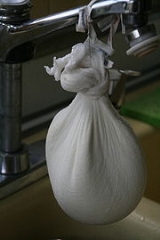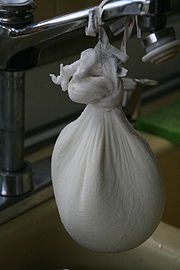
Cheesecloth
Encyclopedia

Gauze
Gauze is a thin, translucent fabric with a loose open weave.-Uses and types:Gauze was originally made of silk and was used for clothing. It is now used for many different things, including gauze sponges for medical purposes. When used as a medical dressing, gauze is generally made of cotton...
-like cotton
Cotton
Cotton is a soft, fluffy staple fiber that grows in a boll, or protective capsule, around the seeds of cotton plants of the genus Gossypium. The fiber is almost pure cellulose. The botanical purpose of cotton fiber is to aid in seed dispersal....
cloth used primarily in cheese
Cheese
Cheese is a generic term for a diverse group of milk-based food products. Cheese is produced throughout the world in wide-ranging flavors, textures, and forms....
making and cooking.
Cheesecloth is available in at least seven different grades, from open to extra-fine weave. Grades are distinguished by the number of threads per inch in each direction.
| Grade | Vertical × horizontal threads per inch |
|---|---|
| #10 | 20 × 12 |
| #40 | 24 × 20 |
| #50 | 28 × 24 |
| #60 | 32 × 28 |
| #90 | 44 × 36 |
Uses
The primary use of cheesecloth is in cheesemaking, where it is used to remove wheyWhey
Whey or Milk Serum is the liquid remaining after milk has been curdled and strained. It is a by-product of the manufacture of cheese or casein and has several commercial uses. Sweet whey is manufactured during the making of rennet types of hard cheese like cheddar or Swiss cheese...
from cheese curds. Cheesecloth is also used in straining stocks and custards, bundling herbs, making tofu
Tofu
is a food made by coagulating soy milk and then pressing the resulting curds into soft white blocks. It is part of East Asian and Southeast Asian cuisine such as Chinese, Japanese, Korean, Indonesian, Vietnamese, and others. There are many different varieties of tofu, including fresh tofu and tofu...
, and thickening yogurt.
Cheesecloth was used as a material for making shirts during the 1960s and 1970s.
Cheesecloth can also be used for several printmaking
Printmaking
Printmaking is the process of making artworks by printing, normally on paper. Printmaking normally covers only the process of creating prints with an element of originality, rather than just being a photographic reproduction of a painting. Except in the case of monotyping, the process is capable...
processes including lithography
Lithography
Lithography is a method for printing using a stone or a metal plate with a completely smooth surface...
for wiping up gum arabic
Gum arabic
220px|thumb|right|Acacia gumGum arabic, also known as acacia gum, chaar gund, char goond, or meska, is a natural gum made of hardened sap taken from two species of the acacia tree; Acacia senegal and Acacia seyal...
. In intaglio
Intaglio (printmaking)
Intaglio is a family of printmaking techniques in which the image is incised into a surface, known as the matrix or plate, and the incised line or area holds the ink. Normally, copper or zinc plates are used as a surface, and the incisions are created by etching, engraving, drypoint, aquatint or...
a heavily starched cheesecloth called tarlatan is used for wiping away excess ink from the printing surface.
Cheesecloth has been used to create the illusion of "ectoplasm" during spirit channelings or other ghost related phenomena.
Cheesecloth #60 is used in regulatory testing for potential fire hazards. Cheesecloth is wrapped tightly over the device under test, which is then subjected to simulated conditions such as lightning surges conducted through power or telecom cables, power faults, etc. The device may be destroyed but must not ignite the cheesecloth.
Cheesecloth made to United States
United States
The United States of America is a federal constitutional republic comprising fifty states and a federal district...
Federal Standard CCC-C-440 is used to test the durability of optical coatings per United States Military Standard MIL-C-48497. The optics are exposed to a 95%-100% humidity environment at 120°F for 24 hours, and then a 1/4" thick by 3/8" wide pad of cheese cloth is rubbed over the optical surface for at least 50 strokes under at least 1 pound of force. The optical surface is examined for streaks or scratches, and then its optical performance is measured to ensure that no deterioration occurred.
Cheesecloth may also be wrapped around young trees in order to protect them from cicadas.

